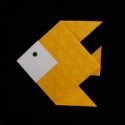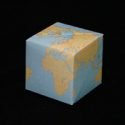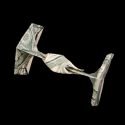Origami Inspirations
by Meenakshi Mukerji

Section 1: Introduction
Origami Inspirations is 120 pages long and it is divided into six sections. The first section has information on origami symbols, bases, tools, paper, and tips & hints for success. This section also includes a brief introduction to Platonic, Archimedean, and Kepler-Poinsot solids. Most of the origami models made in this book are based on these polyhedral shapes.
As suggested by the title, the models in this section are all cubes. All of the cubes require folding a square sheet of paper into thirds. The Plain Cube and Plain Cube 2 are the easiest and require 6 and 12 units respectively. [Photo: Plain Cube , Plain Cube 2]


Ray Cube , Thatch Cube , Whirl Cube
These cubes are made with 24 sheets of paper each. The units are folded such that the white sheet of the paper (back side) is also visible.
- using different sides of the paper as top side,
- interchanging pockets and tabs, and
- positioning of the units based on their color.
For example, there are 12 variations of the Ray Cube, four of which are shown on the right:
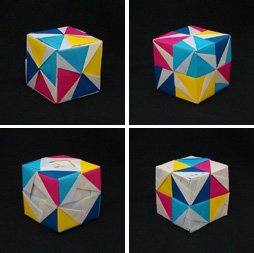
The 3rd section of the book is devoted to Floral Cubes which are made from the “four-sink windmill” base. Though this origami base is not particularly difficult to fold, it is quite involved. Readers who wish to make these floral cubes should be comfortable with the sink fold and should expect to spend about 10 to 15 minutes to fold each unit. Each model is made with 6 units and are effectively cubes with fancy faces. Shown are:

Flower Cube and variations;

Flower Cube 2 and variations;

Flower Cube 3 , Flower Cube 4 , and Butterfly Cube
Straying from the typical “square sheet of paper”, section 4 of Origami Inspirations uses paper in the shape of a pentagon. Mukerji provides clear instructions on how to obtain a pentagon from a square. Despite these good instructions, creating a perfect pentagon is not trivial; most of the problem coming from the error due to the thickness of the paper and errors in folding exactly along the indicated lines.
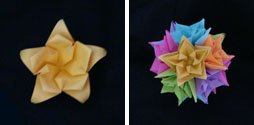
Oleander , Oleander Ball
Of this set, the Oleander is the easiest and most forgiving model. It can be a standalone model, or 12 units can be assembled into an Oleander Ball. Because only 12 units are required, this model is also the fastest one to complete.
Flower Dodecahedron 1 through 5 (below) are all folded in a similar manner: they require 12 pentagon units (for the 12 faces of the model) and 30 connector units. Because you need to cut, fold, and assemble a total of 42 units for each model, these Flower Dodecahedra take a considerable amount of time to complete.
In addition, care must be taken when cutting the pentagons and connector units. Small discrepancies in the unit sizes will amplify themselves dramatically in the final model.
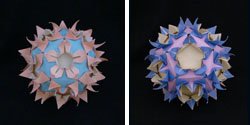

Flower Dodecahedron 3 & 4 are similar to one another and only slightly different from the previous two models. Here the flap are folded down to form central patterns.
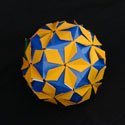
Meenakshi Mukerji’s final chapter is devoted to miscellaneous models: models that don’t quite fit with the other categories but are too good to omit.

Windmill Base Cube , Windmill Base Cube 2 , Wave
In the entire book, the two easiest models are Windmill Base Cube and Windmill Base Cube 2. Both of these models require 6 easy-to-fold units and 12 super-easy connector units. Assembly is trivial and results are quite satisfying.
Again, straying from the classic “square sheet of paper”, the model Wave uses a rectangle in a 1:6 ratio. The units are very easy to fold; however, assembly of Waves is easier if you use miniature clothespins to hold the units in place during assembly. A stunning model that is relatively easy to make.

Whipped Cream Star , Star with Spirals
Whipped Cream Star and Star with Spirals are two delicious models! They are so named because they look like icing on a cake! The models shown use 30 units, are folded from 1:2 ratio rectangles, and are assembled in a dodecahedron manner. Different models can be made with 12 units, 24 units, and variations in assembly.

3 unit Hexahedron , 4-unit Tetrahedron , 6 unit Cube
Lastly, Mukerji offers Whipped Cream Polyhedra: The units are folded like the Whipped Cream unit but assembled like Sonobe units. Easy to assemble and stable too!
Section 6:
Fear not, there is one more section! The last section of the book is a collection of models from origami artists from around the world. The good part of this section is that new artists bring in fresh ideas – something different and a change from the familiar. And, it’s just nice to let other artists have a moment of fame and enjoy the limelight.
by Daniel Kwan from USA:
Truncated Rhombic Triacontahedron
Four interlocked Triangular Prisms (top image)
by Carlos Cabrino (Leroy) from Brazil:
Chrysanthemum Leroy
Chrysanthemum Leroy variation
Carnation Leroy (second image)
by Tanya Vysochina from Ukraine
Camellia (third image)
Dahlia
Lily of the Nile
Crystal
by Aldo Marcell from Nicaragua
Adaptable Dodecahedron (bottom image)
Adaptable Dodecahedron2

All in all, this is a great origami book for those who are dedicated to modular origami. Many of the models require over 30 units to accomplish, thus one must be committed to the process. Although the units are not necessarily hard to fold, some of them are quite involved and require a certain amount of tenacity. This book is not for beginners; it is well suited for intermediate folders who are stout of character and have a strong sense of determination.
- buy Origami Inspirations here
- see book review of Marvelous Modular Origami
- more book reviews
- Site Map
- Home Page
-
Books with Modular Origami
- Marvelous Modular Origami by Mukerji
- Polyhedron Origami for Beginners (Origami Classroom) by M Kawamura
- Origami Wreaths and Rings by David Petty
- Unit Origami: Multidimensional Transformations by Tomoko Fuse
- Unit Polyhedron Origami by Tomoko Fuse
- Beginner’s Book of Modular Origami Polyhedra: The Platonic Solids by Rona Gurkewitz and Bennett Arnstein
- 3-D Geometric Origami by Rona Gurkewitz and Bennett
- Modular Origami Polyhedra (Origami) by Lewis Simon, Bennett Arnstein, and Rona Gurkewitz
- Multimodular Origami Polyhedra: Archimedeans, Buckyballs and Duality by Rona Gurkewitz and Bennett Arnstein
- Unfolding Mathematics with Unit Origami by Betsy Franco
Please Help
Please help by reporting broken links so that we can fix them. One easy message from you can save us hours and hours of clicking. Thanks!
-
More Origami Diagrams and Instructions…
-
These free origami instructions are made available to you by the paper folding community at large. If you have a diagram you would like to share, or if your diagram is listed here and you wish to have it removed, please Contact Us. Diagrams are intended for personal use. Copyright of the models lie with the origami creators and designers. Please contact the designer and/or creator directly for non-private usage of a model and/or artwork.









